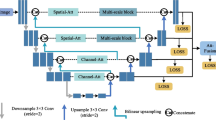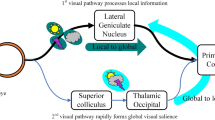Abstract
In the past few years, edge detection models based on convolutional neural networks have made remarkable progress. These models consist of the encoding network and the decoding network. The classification networks (e.g. VGG16) are generally used as the encoding network and the researchers mainly focus on the design of the decoding network. Because natural images contain many edges with different scales, how to make full use of rich and hierarchical convolutional features for edge detection is pivotal. We propose a decoding network that effectively integrates multi-level features from all convolutional layers, named multi-decoding network. Firstly, the side outputs from VGG16 are divided into shallow-, mid-, and deep-level edge features. These edge features are processed separately by multiple independent decoding networks composed of several refinement blocks. Subsequently, to improve the ability of edge fusion, we design a multi-level top-down architecture and a multi-scale attention module, which utilizes the attention mechanism to gradually refine edges. Ultimately, three types of predictions are averaged to produce the final prediction. We evaluate our method on the BSDS500, NYUDv2, and Multicue datasets. Experimental results demonstrate that our model is superior to multiple state-of-the-art edge detection models.









Similar content being viewed by others
Explore related subjects
Discover the latest articles and news from researchers in related subjects, suggested using machine learning.References
Li C, Xia W, Yan Y et al (2021) Segmenting objects in day and night: edge-conditioned cnn for thermal image semantic segmentation. IEEE Trans Neural Netw Learn Syst 32(7):3069–3082. https://doi.org/10.1109/TNNLS.2020.3009373
Zhao L, Zhao Q, Liu H et al (2017) Structural sparse representation-based semi-supervised learning and edge detection proposal for visual tracking. Vis Comput 33(9):1169–1184. https://doi.org/10.1007/s00371-016-1279-z
Zhao JX, Liu JJ, Fan DP et al (2019) EGNet: edge guidance network for salient object detection. In: IEEE international conference on computer vision, Seoul, Korea (South), pp 8779–8788. https://doi.org/10.1109/ICCV.2019.00887
Rampun A, López-Linares K, Morrow PJ (2019) Breast pectoral muscle segmentation in mammograms using a modified holistically-nested edge detection network. Med Image Anal 57:1–17. https://doi.org/10.1016/j.media.2019.06.007
Canny J (1986) A computational approach to edge detection. IEEE Trans Pattern Anal Mach Intell PAMI 8(6):679–698. https://doi.org/10.1109/TPAMI.1986.4767851
Duda RO, Hart PE (1973) Pattern classification and scene analysis. Wiley, New York
Grigorescu C, Petkov N, Westenberg MA (2003) Contour detection based on nonclassical receptive field inhibition. IEEE Trans Image Process 12(7):729–739. https://doi.org/10.1109/TIP.2003.814250
Yang KF, Gao SB, Guo CF et al (2015) Boundary detection using double-opponency and spatial sparseness constraint. IEEE Trans Image Process 24(8):2565–2578. https://doi.org/10.1109/TIP.2015.2425538
Akbarinia A, Parraga CA (2018) Feedback and surround modulated boundary detection. Int J Comput Vis 126(12):1367–1380. https://doi.org/10.1007/s11263-017-1035-5
Arbelaez P, Maire M, Fowlkes C et al (2010) Contour detection and hierarchical image segmentation. IEEE Trans Pattern Anal Mach Intell 33(5):898–916. https://doi.org/10.1109/TPAMI.2010.161
Martin DR, Fowlkes CC, Malik J (2004) Learning to detect natural image boundaries using local brightness, color, and texture cues. IEEE Trans Pattern Anal Mach Intell 26(5):530–549. https://doi.org/10.1109/TPAMI.2004.1273918
Hallman S, Fowlkes CC (2015) Oriented edge forests for boundary detection. In: IEEE conference on computer vision and pattern recognition, Boston, MA, USA, pp 1732–1740. https://doi.org/10.1109/CVPR.2015.7298782
Xie S, Tu Z (2015) Holistically-nested edge detection. In: IEEE international conference on computer vision, Santiago, Chile, pp 1395–1403. https://doi.org/10.1109/ICCV.2015.164
Liu Y, Cheng MM, Hu X et al (2018) Richer convolutional features for edge detection. IEEE Trans Pattern Anal Mach Intell 41(8):1939–1946. https://doi.org/10.1109/TPAMI.2018.2878849
Wang Y, Zhao X, Li Y et al (2018) Deep crisp boundaries: from boundaries to higher-level tasks. IEEE Trans Image Process 28(3):1285–1298. https://doi.org/10.1109/TIP.2018.2874279
Yang H, Li Y, Yan X et al (2019) ContourGAN: image contour detection with generative adversarial network. Knowl Based Syst 164:21–28. https://doi.org/10.1016/j.knosys.2018.09.033
Zhang R, You M (2021) Fast contour detection with supervised attention learning. J Real Time Image Process 18(3):647–657. https://doi.org/10.1007/s11554-020-00980-1
Cao YJ, Lin C, Li YJ et al (2020) Learning crisp boundaries using deep refinement network and adaptive weighting loss. IEEE Trans Multimed 23:761–771. https://doi.org/10.1109/TMM.2020.2987685
Silberman N, Hoiem D, Kohli P et al (2012) Indoor segmentation and support inference from RGBD images. In: European conference on computer vision, Florence, Italy, pp 746–760. https://doi.org/10.1007/978-3-642-33715-4_54
Mély DA, Kim J, McGill M et al (2016) A systematic comparison between visual cues for boundary detection. Vis Res 120:93–107. https://doi.org/10.1016/j.visres.2015.11.007
Simonyan K, Zisserman A (2015) Very deep convolutional networks for large-scale image recognition. In: International conference on learning representations, San Diego, CA, USA, pp 1–14. https://arxiv.org/abs/1409.1556
He K, Zhang X, Ren S et al (2016) Deep residual learning for image recognition. In: IEEE conference on computer vision and pattern recognition, Las Vegas, NV, USA, pp 770–778. https://doi.org/10.1109/CVPR.2016.90
Lin T, Dollár P, Girshick R et al (2017) Feature pyramid networks for object detection. In: IEEE conference on computer vision and pattern recognition, Honolulu, HI, USA, pp 936–944. https://doi.org/10.1109/CVPR.2017.106
Chen L, Papandreou G, Kokkinos I et al (2017) DeepLab: semantic image segmentation with deep convolutional nets, atrous convolution, and fully connected CRFs. IEEE Trans Pattern Anal Mach Intell 40(4):834–848. https://doi.org/10.1109/TPAMI.2017.2699184
Sandler M, Howard A, Zhu M et al (2018) MobileNetV2: inverted residuals and linear bottlenecks. In: IEEE conference on computer vision and pattern recognition, Salt Lake City, UT, USA, pp 4510–4520. https://doi.org/10.1109/CVPR.2018.00474
Woo S, Park J, Lee JY et al (2018) CBAM: convolutional block attention module. In: European conference on computer vision, Munich, Germany, pp 3–19. https://doi.org/10.1007/978-3-030-01234-2_1
Hendrycks D, Gimpel K (2016) Gaussian error linear units (gelus). Preprint https://arxiv.org/abs/1606.08415
Mottaghi R, Chen X, Liu X et al (2014) The role of context for object detection and semantic segmentation in the wild. In: IEEE conference on computer vision and pattern recognition, Columbus, OH, USA, pp 891–898. https://doi.org/10.1109/CVPR.2014.119
Gupta S, Girshick R, Arbeláez P et al (2014) Learning rich features from RGB-D images for object detection and segmentation. In: European conference on computer vision, Zurich, Switzerland, pp 345–360. https://doi.org/10.1007/978-3-319-10584-0_23
Deng R, Shen C, Liu S et al (2018) Learning to predict crisp boundaries. In: European conference on computer vision, Zurich, Switzerland, pp 562–578. https://doi.org/10.1007/978-3-030-01231-1_35
He J, Zhang S, Yang M et al (2019) Bi-directional cascade network for perceptual edge detection. In: IEEE conference on computer vision and pattern recognition, Long Beach, CA, USA, pp 3828–3837. https://doi.org/10.1109/CVPR.2019.00395
Shen W, Wang X, Wang Y et al (2015) Deepcontour: a deep convolutional feature learned by positive-sharing loss for contour detection. In: IEEE conference on computer vision and pattern recognition, Boston, MA, USA, pp 3982–3991. https://doi.org/10.1109/CVPR.2015.7299024
Bertasius G, Shi J, Torresani L (2015) Deepedge: a multi-scale bifurcated deep network for top-down contour detection. In: IEEE conference on computer vision and pattern recognition, Boston, MA, USA, pp 4380–4389. https://doi.org/10.1109/CVPR.2015.7299067
Maninis KK, Pont-Tuset J, Arbeláez P et al (2017) Convolutional oriented boundaries: from image segmentation to high-level tasks. IEEE Trans Pattern Anal Mach Intell 27:1676–1688. https://doi.org/10.1109/TPAMI.2017.2700300
Yang JM, Price B, Cohen S et al (2016) Object contour detection with a fully convolutional encoder-decoder network. In: IEEE conference on computer vision and pattern recognition, Las Vegas, NV, USA, pp 193–202. https://doi.org/10.1109/CVPR.2016.28
Kelm AP, Rao VS, Zölzer U (2019) Object contour and edge detection with refinecontournet. In: 18th Computer analysis of images and patterns, Salerno, Italy, pp 246–258. https://doi.org/10.1007/978-3-030-29888-3_20
Dollár P, Zitnick CL (2015) Fast edge detection using structured forests. IEEE Trans Pattern Anal Mach Intell 37(8):1558–1570. https://doi.org/10.1109/TPAMI.2014.2377715
Gupta S, Arbelaez P, Malik J (2013) Perceptual organization and recognition of indoor scenes from RGB-D images. In: IEEE conference on computer vision and pattern recognition, Portland, OR, USA, pp 564–571. https://doi.org/10.1109/CVPR.2013.79
Acknowledgements
This work was supported by the National Natural Science Foundation of China (Grant No. 61866002), Guangxi Natural Science Foundation (Grant Nos. 2020GXNSFDA297006, 2018GXNSFAA138122, 2015GXNSFAA139293), and Innovation Project of Guangxi Graduate Education (Grant No. YCSW2021301).
Author information
Authors and Affiliations
Corresponding author
Additional information
Publisher's Note
Springer Nature remains neutral with regard to jurisdictional claims in published maps and institutional affiliations.
Rights and permissions
Springer Nature or its licensor (e.g. a society or other partner) holds exclusive rights to this article under a publishing agreement with the author(s) or other rightsholder(s); author self-archiving of the accepted manuscript version of this article is solely governed by the terms of such publishing agreement and applicable law.
About this article
Cite this article
Zhang, X., Lin, C. Multi-decoding Network with Attention Learning for Edge Detection. Neural Process Lett 55, 4889–4906 (2023). https://doi.org/10.1007/s11063-022-11070-7
Accepted:
Published:
Issue Date:
DOI: https://doi.org/10.1007/s11063-022-11070-7




